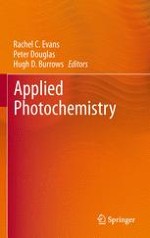Abstract
This chapter gives an introduction to the key ideas which underpin photochemistry: the nature of electromagnetic radiation, the nature of matter, and the way the two interact. After a discussion of ultraviolet and visible electromagnetic radiation and its interaction with the optical properties of materials, an account is given of the fundamental properties of the four components involved in photochemistry, the protons, neutrons and electrons which make up atoms, and the photon. The ideas of wave mechanics and its application to atomic structure are introduced in a non-mathematical way, with atomic orbitals described in terms of quantum numbers, energies, degeneracies, shapes and symmetries. The role of electron spin in governing orbital occupancy is discussed, along with the structure of many-electron atoms and the use of term symbols to identify the various spin, orbital, and total angular momenta of atomic states. The use of atomic orbitals as constructs for molecular orbitals and molecular bonding is described. Term symbols for small molecules are illustrated briefly using O2, which is particularly important in photochemistry, as an example. The concepts of a Highest Occupied Molecular Orbital (HOMO) and Lowest Unoccupied Molecular Orbital (LUMO) are introduced, and the importance of these orbitals in photochemistry is explained. Bonding in conjugated systems, metals and semiconductors is described. The link between energy levels and electrochemical redox potentials is made. The various energy states in atoms molecules and solids, and the way energy is distributed within these energy levels according to the Boltzmann equation, are described. Timescales for various physical and photochemical processes are given. The interaction of electronic energy states with ultraviolet and visible light is discussed in terms of absorption, emission and stimulated emission, using the Einstein A and B coefficients, transition probabilities, and absorption coefficients. The absorption process and the various selection rules which control the efficiency of absorption, and emission, are described, as are the common types of electronic transitions. Absorption in gas, solution, and solid phases, and the effect of aggregation on absorption in solution, are discussed. Unimolecular radiative and non-radiative excited state deactivation processes are discussed in terms of the Jablonski diagram, and the ideas of, competition between decay routes, and quantum yield, are introduced. Bimolecular interactions, quenching and energy transfer are described, with Förster Resonance Energy Transfer (FRET) and Dexter energy transfer discussed in some detail, and the analysis of bimolecular quenching kinetics using the Stern–Volmer equation is given. The chapter finishes with brief discussions of excimers, exciplexes, delayed fluorescence and proton transfer.
